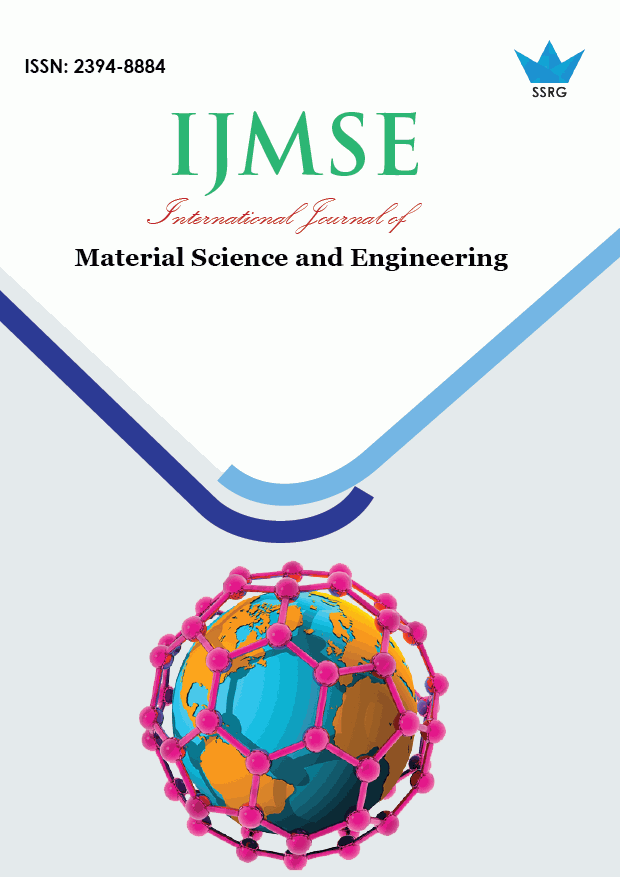Synthesis and Characterization of Ce Incorporated BiFeO3-BaTiO3 Ceramic near the Morphotropic Phase Boundary

| International Journal of Material Science and Engineering |
| © 2019 by SSRG - IJMSE Journal |
| Volume 5 Issue 2 |
| Year of Publication : 2019 |
| Authors : Mst. Sharmin Mostari, Md. Nurul Islam |
How to Cite?
Mst. Sharmin Mostari, Md. Nurul Islam, "Synthesis and Characterization of Ce Incorporated BiFeO3-BaTiO3 Ceramic near the Morphotropic Phase Boundary," SSRG International Journal of Material Science and Engineering, vol. 5, no. 2, pp. 13-17, 2019. Crossref, https://doi.org/10.14445/23948884/IJMSE-V5I2P103
Abstract:
Cerium-doped Bismuth Ferrite- Barium Titanate ceramics were prepared using the conventional solid-state reaction method near the morphotropic phase boundary. The synthesized samples were subjected to structural, morphological and di-electric characterization. The obtained structure was distorted perovskite, without indication of any impurity phase confirmed by X-ray diffraction. Besides, modification with cerium in small scale influenced the microstructure and dielectric property remarkably. Grain growth suppression phenomenon was observed with cerium addition. Moreover, the doped samples also exhibited improved dielectric properties. The maximum dielectric constant of around 700, had been found for x = 0.04.
Keywords:
Cerium, BiFeO3-BaTiO3, Donor dopant, SEM, Dielectric properties
References:
[1] Wodecka-Duś and D. Czekaj, “Synthesis of 0.7BiFeO3-0.3BaTiO3 Ceramics: Thermal, structural and AC impedance studies,” Arch. Metall. Mater., vol. 56, pp. 1127–1136, 2011.
[2] R. A. M. Gotardo et al., “Ferroic states and phase coexistence in BiFeO3-BaTiO3 solid solutions,” J. Appl. Phys., 2012.
[3] L. Luo, L. Zhou, X. Zou, Q. Zheng, and D. Lin, “Structure, piezoelectric and multiferroic properties of Bi(Ni0.5Mn0.5)O3-modified BiFeO3–BaTiO3 ceramics,” J. Mater. Sci. Mater. Electron., vol. 26, pp. 9451–9462, 2015.
[4] N. A. Hill, “Why Are There so Few Magnetic Ferroelectrics?,” J. Phys. Chem. B, vol. 104, pp. 6694–6709, 2002.
[5] M. M. Kumar, V. R. Palkar, K. Srinivas, and S. V. Suryanarayana, “Ferroelectricity in a pure BiFeO3 ceramic,” Appl. Phys. Lett., vol. 76, pp. 2764–2766, 2000.
[6] S. Shankar and M. Kumar, “Electrical Properties of BiFeO3 - BaTiO3 Ceramics,” vol. 4, pp. 25–30, 2014.
[7] L. Feng et al., “Piezoelectric, ferroelectric and ferromagnetic properties of (1 − x) BiFeO3 – x BaTiO3 lead-free ceramics near morphotropic phase boundary,” J. Mater. Sci. Mater. Electron., vol. 29, pp. 2307–2315, 2018.
[8] Q. Hang et al., “Dielectric properties and related ferroelectric domain configurations in multiferroic BiFeO3-BaTiO3 solid solutions,” Ceram. Int., vol. 38, pp. S411–S414, 2012.
[9] M. M. Kumar, A. Srinivas, and S. V. Suryanarayana, “Structure property relations in BiFeO3/BaTiO3 solid solutions,” J. Appl. Phys., vol. 87, pp. 855–862, 2000.
[10] Y. Wei, X. Wang, J. Jia, and X. Wang, “Multiferroic and piezoelectric properties of 0.65BiFeO3-0.35BaTiO3 ceramic with pseudo-cubic symmetry,” Ceram. Int., vol. 38, pp. 3499–3502, 2012.
[11] M. Liu et al., “Critical roles of Mn-ions in enhancing the insulation, piezoelectricity and multiferroicity of BiFeO3 -based lead-free high temperature ceramics,” J. Mater. Chem. C, vol. 3, pp. 5811–5824, 2015.
[12] C. Behera and A. K. Pattanaik, “Structural, dielectric and ferroelectric properties of lead free Gd-modified BiFeO3–BaTiO3 solid solution,” J. Mater. Sci. Mater. Electron., 2019.
[13] J. Liu, M. Li, L. Pei, B. Yu, and D. Guo, “Effect of Ce doping on the microstructure and electrical properties of BiFeO3 thin films prepared by chemical,” 2009.
[14] X. Wu, X. Wu, L. Luo, Q. Zheng, and D. Lin, “Enhanced multiferroic property in Co2O3-added BiFeO3-BaTiO3 ceramics,” J. Ceram. Soc. Japan, vol. 123, pp. 972–977, 2015.
[15] C. Zhou et al., “Dielectric, ferroelectric and piezoelectric properties of La-substituted BiFeO3-BaTiO3 ceramics,” Ceram. Int., vol. 39, pp. 4307–4311, 2013.
[16] S. N. Das, A. Pattanaik, S. Kadambini, S. Pradhan, S. Bhuyan, and R. N. P. Choudhary, “Dielectric and impedance spectroscopy of Ni doped BiFeO3 -BaTiO3 electronic system,” J. Mater. Sci. Mater. Electron., vol. 27, pp. 10099–10105, 2016.
[17] H. Liu and X. Yang, “Structural, dielectric, and magnetic properties of BiFeO3-SrTiO3 solid solution ceramics,” Ferroelectrics, vol. 500, pp. 310–317, 2016.
[18] M. Zhang, X. Zhang, X. Qi, Y. Li, L. Bao, and Y. Gu, “Effects of sintering temperature and composition on dielectric, ferroelectric, and magnetoelectric properties of BaTiO3–BiFeO3 solid solutions,” Ceram. Int., vol. 43, pp. 16957–16964, 2017.
[19] X. Qi et al., “Compositional dependence of ferromagnetic and magnetoelectric effect properties in BaTiO3– BiFeO3–LaFeO3 solid solutions,” RSC Adv., vol. 3, pp. 51801–51806, 2017.

 10.14445/23948884/IJMSE-V5I2P103
10.14445/23948884/IJMSE-V5I2P103